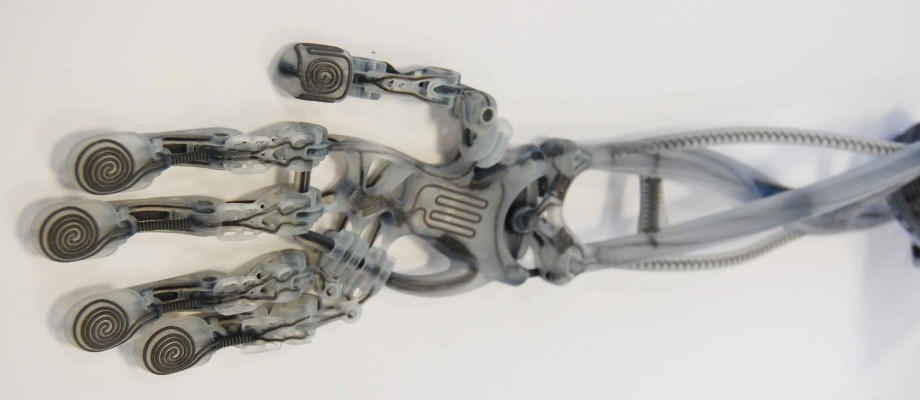
A new industrial age takes shape
November 2nd, 2014
Researchers at Nottingham helped create a landmark exhibition at London’s Science Museum to showcase a technology that is transforming manufacturing.
Additive manufacturing or 3D printing has been termed a new industrial revolution. Using digital data, 3D printers print multiple thin layers of material such as polymer or metal, usually in powder form, which are then fused by lasers to form solid objects.
The technology allows levels of flexibility and customisation beyond traditional industrial methods and is revolutionising approaches to design and manufacturing.
The Additive Manufacturing and 3D Printing Research Group (3DPRG) at the University is recognised as the world’s leading research centre in the field. 3DPRG, which hosts the national EPSRC (Engineering and Physical Sciences Research Council) Centre for Innovative Manufacturing in Additive Manufacturing and has a research portfolio in excess of £10m, is a sponsor and adviser to the exhibition, 3D: printing the future, which opened at the Science Museum this month.
Student interns created one of the highlights of the exhibition — a 3D-printed functionalised prosthetic arm illustrating how the technology could evolve to print customised prosthetics with electronic moving parts and nerve endings.
Professor Richard Hague, Professor of Innovative Manufacturing and leader of the research group, said the University was delighted to support the exhibition.
The impact of additive manufacturing — so-called because it uses 3D printers to build up material — is growing rapidly. The wider availability of 3D printers and the prospect of goods being customised and printed at home or on the high street has further raised interest.
Suzy Antoniw of the Science Museum said: “We are indebted to Nottingham’s Additive Manufacturing and 3D Printing Research Group for all the support they have given to this exhibition. The prototype prosthetic hand developed by Richard and his students (and showcased in the exhibition) is a prime example of how 3D-printed innovations could transform people’s lives.”
Mary Amos and Matthew Cardell-Williams, who are studying Product Design and Manufacture (MEng), and Scott Wimhurst, a Mechanical Engineering (MEng) student, worked on the prosthetic arm during their summer research placement with 3DPRG. Their brief was to conceptualise the future applications of multi-functional and multi-material 3D printing.
“We worked as a team to create a range of different concepts and eventually narrowed it down to an active prosthetic of an arm as we thought it was an appropriate application for the technology and was easy to communicate to a wide audience,” they said.
As well as the prosthetic arm created in Nottingham, the exhibition features 3D-printed pharmaceutical tablets, one of a number of collaborations between 3DPRG and the University’s School of Pharmacy. Some of the printed tablets are bilayered, allowing two different drugs to be released at varying speeds according to individual patient need.
The 3DPRG researchers were recently awarded a £2.7m grant from EPRSC to work with the School of Pharmacy. Professor Clive Roberts, head of the School of Pharmacy, said 3D printing of solid medicines at point-of-care offered personalised patient treatments beyond the scope of conventional mass manufacturing.
He added: “While there are many practical and regulatory issues to consider I firmly believe that 3D printing will be used in the medicines manufactured in the future.”
The Science Museum will also look at how engineers are using 3D printing to create lighter and more sustainable aerospace parts. This is being explored by Professor Hague’s team and the University’s Institute for Aerospace Technology.
Professor Hague said additive manufacturing would help transform the industrial landscape, with more emphasis on smaller, localised manufacturing.
He said Nottingham is leading research into the next phase of Additive Manufacturing: the 3D printing of mixed materials in multifunctional devices.
While 3D printing was at present capable of printing single materials into complex geometries, the results were passive. “What we’re looking to do is activate those and make them functionalise,” he said. “So rather than make a component you make the whole system — an example might be rather than print a case for a mobile phone you make the whole phone — all the electronics, the case, the structural aspects, all in one print.”
Another exciting development is new research into the direct 3D printing of metal. “That will be globally unique – nobody else will be working on that,” said Professor Hague.
3D: printing the future is as the Science Museum, London, for the next 9 months.
www.sciencemuseum.org.uk
Tags: 3D printing, 3D: printing the future, 3DPRG, Additive manufacturing, Centre for Innovative Manufacturing in Additive Manufacturing, he Additive Manufacturing and 3D Printing Research Group, Mary Amos, Matthew Cardell-Williams, Professor Clive Roberts, Professor of Innovative Manufacturing, Professor Richard Hague, School of Pharmacy, Science Museum, Suzy Antoniw
Comments are closed.
Other Issue 71



